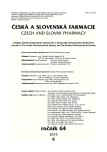Analysis of flavonoids in grape leaves by HPLC-DAD-MS/MS
Authors:
Svetlana Dokupilová; Lucia Veizerová; Jaroslav Galba; Peter Mikuš
Authors place of work:
Faculty of Pharmacy, Comenius University, Bratislava, Slovak Republic
Published in the journal:
Čes. slov. Farm., 2015; 64, 283
Category:
44<sup>th</sup> Conference drug synthesis and analysis
Introduction
Flavonoids are water soluble polyphenolic molecules which belong to a group of plant metabolites thought to provide health benefits through cell signalling pathways and antioxidant effects. Flavonoids are the most abundant and widely studied, and have enjoyed greater attention among grape researchers1).
Experimental methods
Grape leaves of various grape varieties obtained from the Research Institute of Viticulture and Enology in Slovakia were analysed. Samples were collected in September 2013. Leaves were dried and frozen (–20 °C) until treated prior to analysis. Samples were homogenized and 2.5 g of each sample was extracted with a 40 ml mixture of methanol/water 80 : 20 (v/v) for 120min and 2 × 20 ml dichloromethene was used for sample clean-up. 2.5 ml of the water-methanolic part was dried and dissolved in the mobile phase. Analysis was performed on an LC Agilent 1200 Infinity System (Agilent Technologies, USA) with an Agilent 1260 Infinity Diode Array Detector and an Agilent 6520 Accurate-Mass Quadrupole Time-of-Flight. Separation column was Kromasil C18 (4.0 × 150 mm, 3.5 μm). Mobile phase consisted of acetonitrile and formate buffer (ammonium formate of the concentration 10 mmol/l and pH adjusted to 3.1 by formic acid). Gradient elution 10–95% of acetonitrile in 62 min was used.
MS Detection conditions were: negative mode (ESI–), capillary voltage: 3.5 kV, drying gas temperature: 300 °C, drying gas flow rate: 10 l/min, nebulizer pressure: 40 psi, fragmentor voltage: 140 V, collision energy: 20 eV.
Results and discussion
Identification of the separated compounds was carried out using a UV, MS and MS/MS spectra. 7 quercetin and 4 kaempferol glycoside flavonoids (quercetin-3-O-rutinoside, quercetin-glucuronide, quercetin-3-O-galactoside, quercetin-3-O-glucoside, quercetin-pentoside 1, kaempferol-3-O-rutinoside, kaempferol-hexoside 1, quercetin- -pentoside 2, quercetin-3-O-rhamnoside, kaempferol-hexoside 2, kaempferol-deoxyhexoside) were identified. A DAD detector and external calibration curves of quercetin and kaempferol (in the range 5–100 μg/ml) were used for quantification. 9 of the 13 identified compounds could be quantified (Table 1).

It was found that the highest contained flavonoid was quercetin-glucuronide, the content of which ranged from 1385 to 7284 μg/g. The amount of other components varied from 41.79 μg/g to the maximum value of 4665 μg/g. The method validation confirmed sufficient linearity, precision, accuracy and separation efficiency. Low limits of detection and limit of quantification (LOD = 1.12 μg/g, LOQ = 3.73 μg/g for quercetin and LOD = 2.35 μg/g, LOQ = 7.84 μg/g for kaempferol) were detected.
Conclusions
It was confirmed that the proposed method is suitable for a comprehensive analysis of complex plant matrices, such as grape leaves. The results of research will contribute to the creation of profiles of pharmaceutically active substances contained in the leaves of nearly 30 Slovak vine varieties that could be used in the future to prepare nutraceuticals.
Research was supported by grant APVV-0550-11.
Conflicts of interest: none.
RNDr. Svetlana Dokupilová, PhD.
Department of Pharmaceutical Analysis and Nuclear Pharmacy
Faculty of Pharmacy, Comenius University
Odbojárov 10, 832 32 Bratislava, Slovak Republic
e-mail: dokupilova@fpharm.uniba.sk
Zdroje
1. Liu C., et al. Resveratrols in Vitis berry skins and leaves: Their extraction and analysis by HPLC. Food Chem. 2013; 136, 643–649.
Štítky
Farmacie FarmakologieČlánek vyšel v časopise
Česká a slovenská farmacie

2015 Číslo 6
- Přerušovaný půst může mít významná zdravotní rizika
- Ukažte mi, jak kašlete, a já vám řeknu, co vám je
- Top zaměstnavatelé ve zdravotnictví si hýčkají už studenty
Nejčtenější v tomto čísle
- Antibakteriální účinky přírodních látek – silice
- Povrch těla a tělesná hmotnost dospělé české onkologické populace
- Cholinergický systém srdca
- Organická syntéza, Laboratórny manuál
